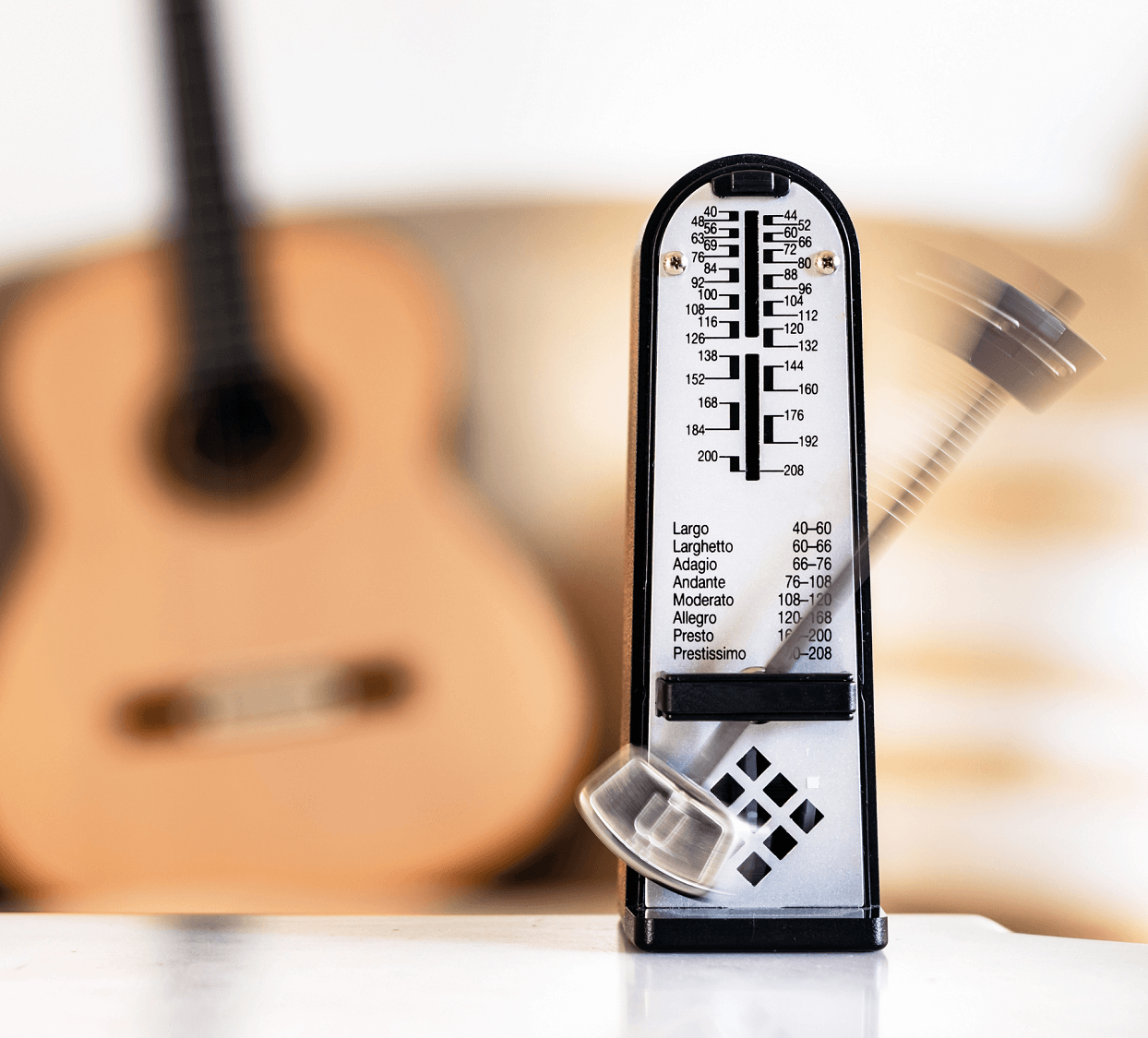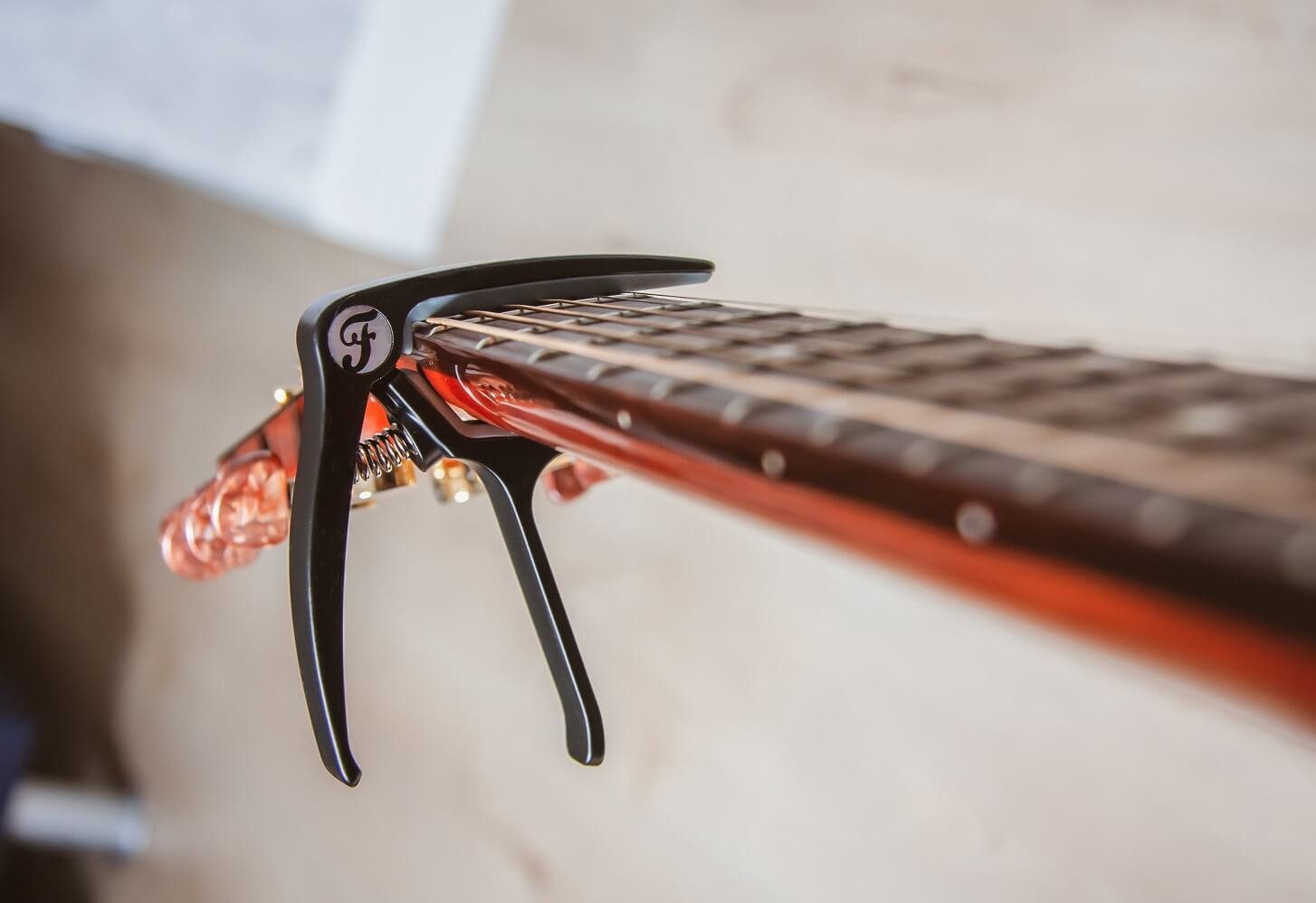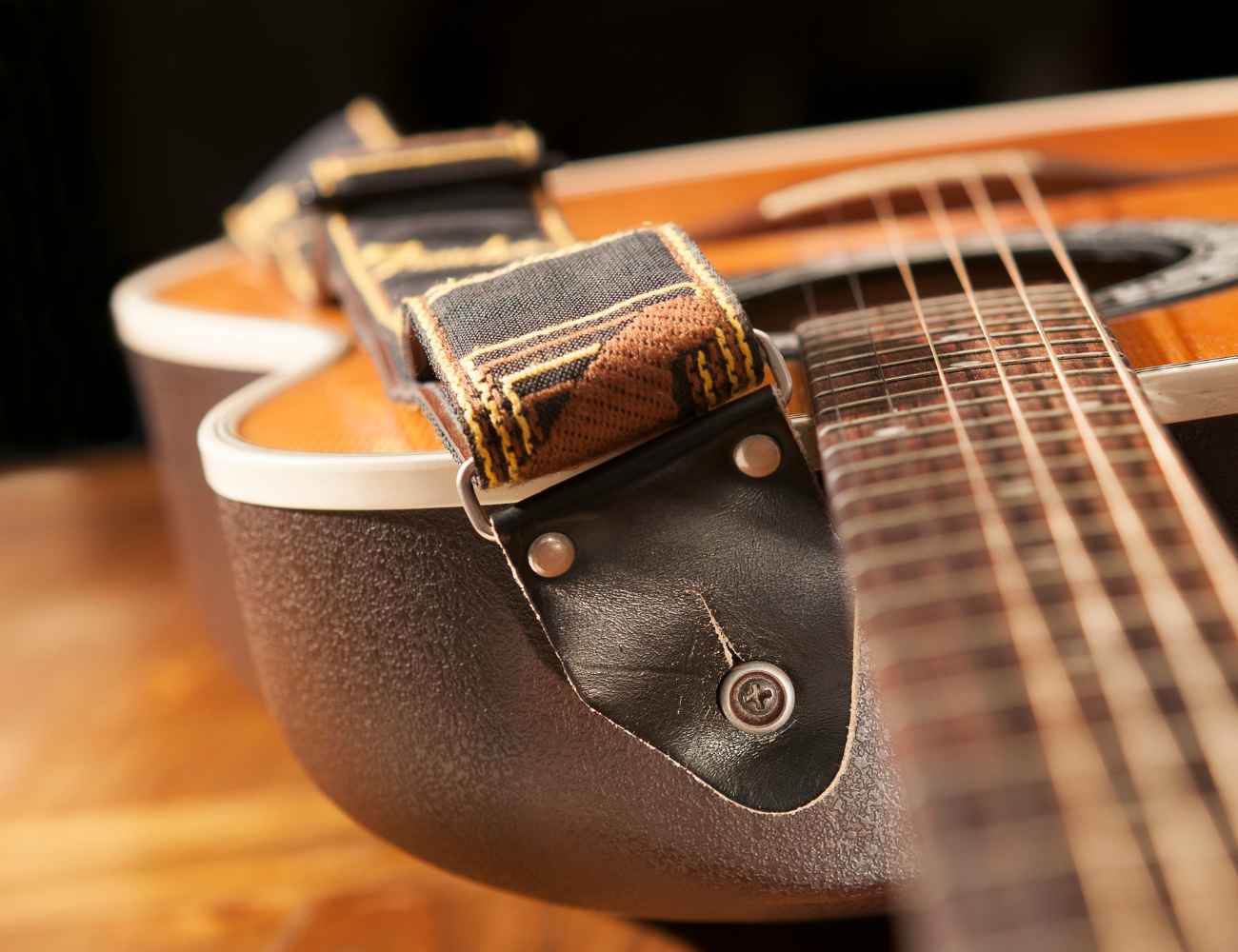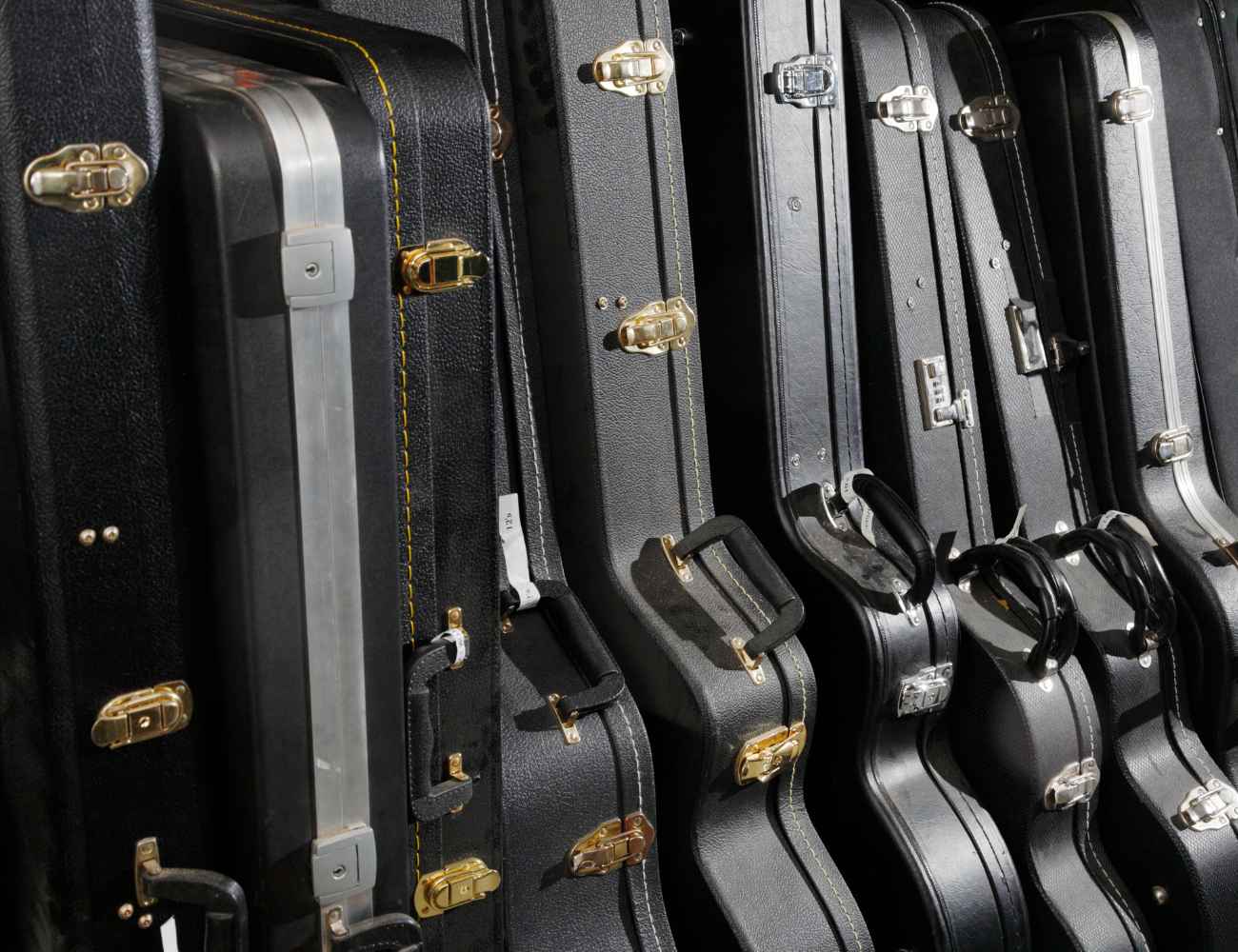What are the best guitar metronomes?
Guitar metronomes are essential tools for helping you keep time while playing your instrument.
A good metronome will help you develop a sense of rhythm and timing, and it can also be a great practice tool.
There are a few things to consider when choosing a guitar metronome, such as size, weight, ease of use, and features.
The best guitar metronomes will be easy to use and have all the features you need to help you keep time while playing your instrument.
You also want a metronome that is small enough to fit in your guitar case or practice space, but not so small that it is difficult to use.
In this post, I will be listing the best guitar metronomes on the market today in terms of quality, durability, versatility, and price, and will also answer some of the most frequently asked questions on this topic.
With that in mind, let’s get started!
Table of Contents
- Best Guitar Metronomes
- KLIQ MetroPitch Digital Metronome
- Ueteto Mechanical Metronome
- KLIQ MicroNome Mini Rechargeable Digital Metronome
- Zhehao Mini Digital Metronome
- LEKATO Guitar Clip On Metronome-Tuner
- Soundbrenner Wearable Vibrating Metronome
- Donner DPM-1 Mechanical Metronome
- Korg MA-1 Visual Beat Counting Metronome
- Seiko SQ50-V Quartz Metronome
- Korg KDM-3 Metronome
- What to consider before buying a guitar metronome?
- How accurate are metronomes?
- Is BPM the same thing as tempo?
- Should you always practice guitar with a metronome?
- What is a good BPM to practice guitar?
- Should all musicians in a band have a metronome when playing together?
Best Guitar Metronomes
KLIQ MetroPitch Digital Metronome
(link to Amazon.com)
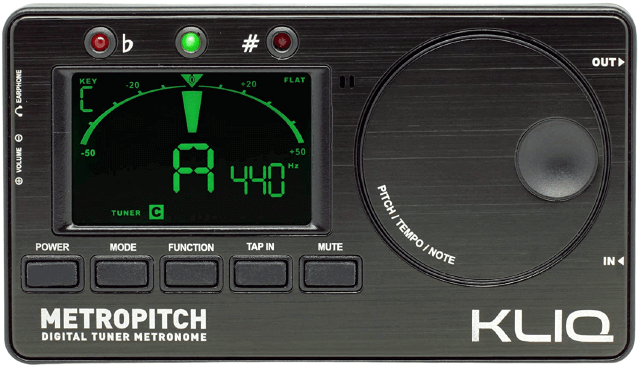
The KLIQ MetroPitch is a versatile, pocket-sized device that combines a tuner, metronome, and tone generator.
Its included carrying pouch makes it easy to transport to your next gig or practice session.
The metronome has a broad range of 30-250 beats per minute, tap tempo, and various beats and rhythm patterns.
Additionally, the tuner has a wide range of A0-C8 and various tuning modes, transposition settings, and pitch calibration.
There’s also an intuitive jog dial that lets you change and put in your desired tempo quickly and easily.
It also allows for making swift pitch selection in the tone generator!
As a very nice extra, the KLIQ MetroPitch comes with a 3-year manufacturer guarantee, so in the unlikely event the device breaks or stops working, you’re covered.
Lastly, the KLIQ MetroPitch is available in red, black, blue, gold, and pewter gray.
Pros:
- Combines a tuner, metronome, and tone generator
- Has a jog dial for easy tempo changes
- 3-year manufacturer guarantee
- Available in multiple colors
Cons:
- Slide buttons can be hard to slide
Ueteto Mechanical Metronome
(link to Amazon.com)
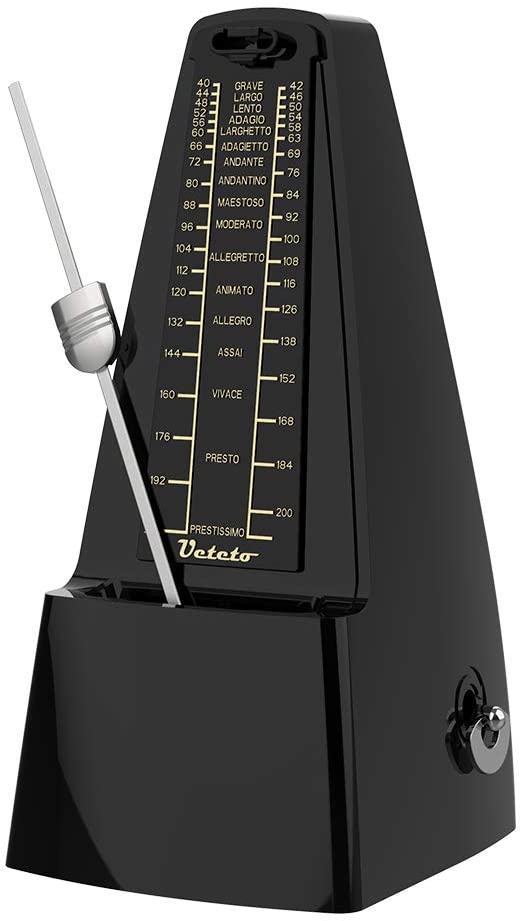
The Ueteto Mechanical Metronome is a metronome that helps you develop rhythm, maintain tempo, play accurately, and increase your musical awareness.
You can use it to produce rhythms at a proper pace when practicing piano, violin, guitar, bass, drum, and other musical instruments.
It features an audible click and bell ring to maintain the rhythm while reading music sheet, a wind-up mechanism that produces metrical beats, and a tempo range of 40-208 bpm.
You can also select the number of beats per measure, from 0 to 6 (0, 2, 3, 4, 6).
The metronome is easy to use, even for children and beginners, since it’s very straightforward to set up and start using.
To use it, you just need to take out the brake, pull off the cover, adjust the beat and tempo, and then you’re ready to go.
The average single full wind (2160 clicks) lasts at least 18 minutes, depending on the tempo; this means that you’ll be able to get a lot of use out of it before needing to wind it up again.
Mechanical tempos were once the industry standard for professional and serious musicians, they are still used today by many because they offer unmatched accuracy.
Pros:
- Easy to use
- Highly accurate
- Wide variety of functions
- Can be used by musicians of all levels
Cons:
- Not as portable as some other metronomes
- It may be difficult to read the tempo markings
KLIQ MicroNome Mini Rechargeable Digital Metronome
(link to Amazon.com)
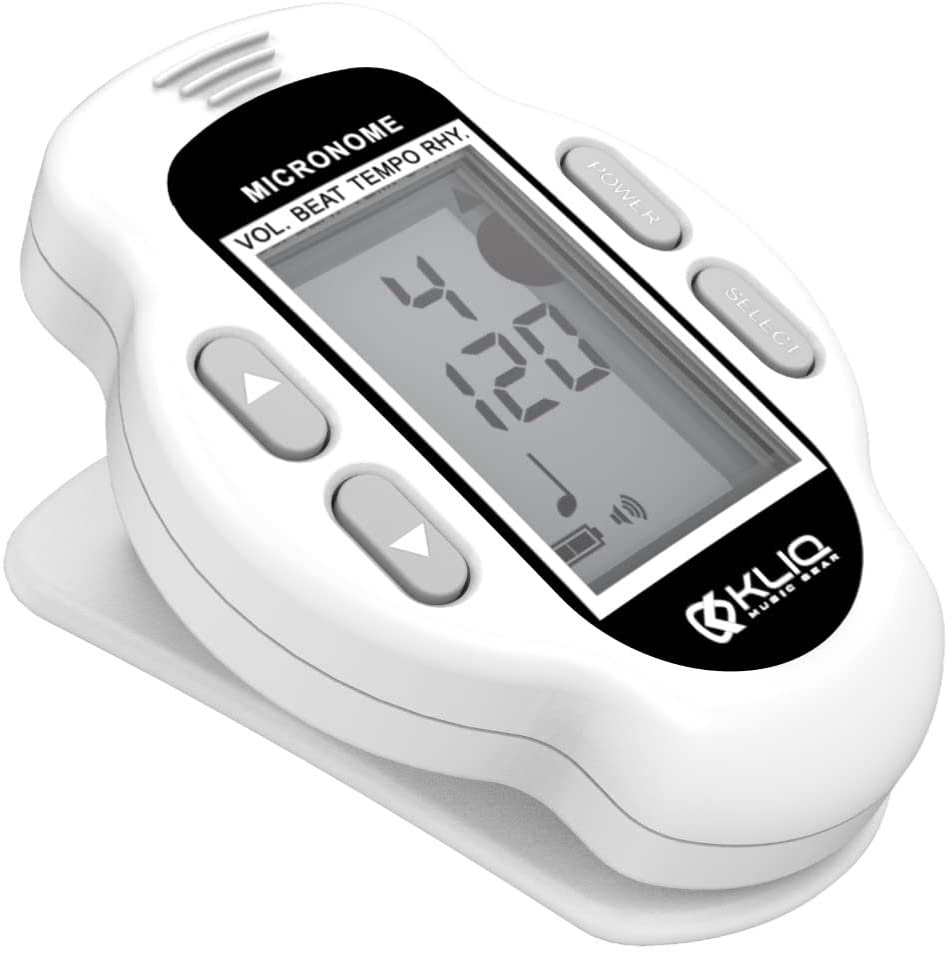
The KLIQ MicroNome is a compact, rechargeable metronome that is easy to use and very versatile.
It has a wide tempo range (30-260 BPM) and can produce different rhythms so that you can practice a variety of different time signatures and beats.
The volume is adjustable, and there is also an energy-saving feature that automatically turns the metronome off after 3 minutes of inactivity.
It also comes with a three-year manufacturer’s guarantee, ensuring that you will be satisfied with your purchase, and is available in white, blue, and red colors.
Additionally, it comes with an easy-to-use clip-on design, making it great for on-the-go practice and portability.
This is one of the few metronomes out there that is simple, affordable, high-quality, and if that wasn’t enough rechargeable.
For those looking for a reliable and versatile metronome to help improve timing and rhythm, the KLIQ MicroNome is a great option to consider.
Pros:
- Wide tempo range
- Volume is adjustable
- Energy-saving feature
- Clip-on design
- Rechargeable
Cons:
- Its high-pitched beep sound can be annoying
Zhehao Mini Digital Metronome
(link to Amazon.com)
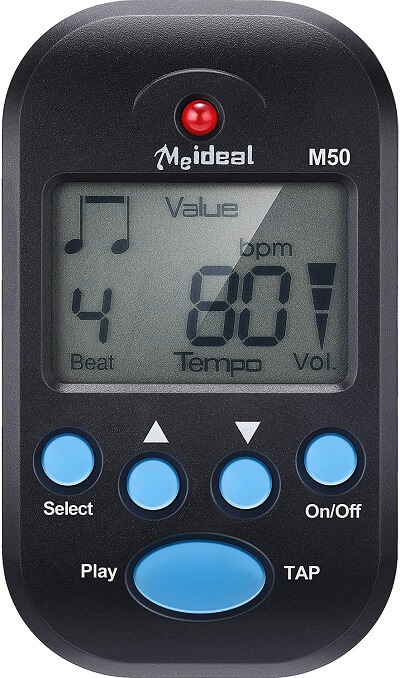
The Zhehao Mini Digital Metronome is a multifunctional, portable device that is clip-on and has adjustable volume with a speaker.
It has a tap tempo which enables users to test their ideal tempo or the tempo of a track within the ranges from 30 to 280 beats per minute.
The metronome also has an earphone jack that is stereo and 3.5 mm compatible.
Such a feature, in particular, allows anybody to keep tempo with music or a track by using headphones, which is ideal for those who practice in small or shared spaces.
The device is easy to operate as it is designed with a back-side clip and 5 buttons on the front side.
Its interface is very straightforward and user-friendly, and it comes with an instruction manual.
Also, the metronome is powered by an included 3V cell battery and is available in 4 colors: black, transparent blue, transparent red, and white.
The different beat values (0-9) give users a variety of options to choose from when setting the tempo.
Pros:
- Very affordable
- Small and lightweight
- Tap tempo feature
- Earphone jack
Cons:
- It has a shrill beep that can be irritating after a while
LEKATO Guitar Clip On Metronome-Tuner
(link to Amazon.com)
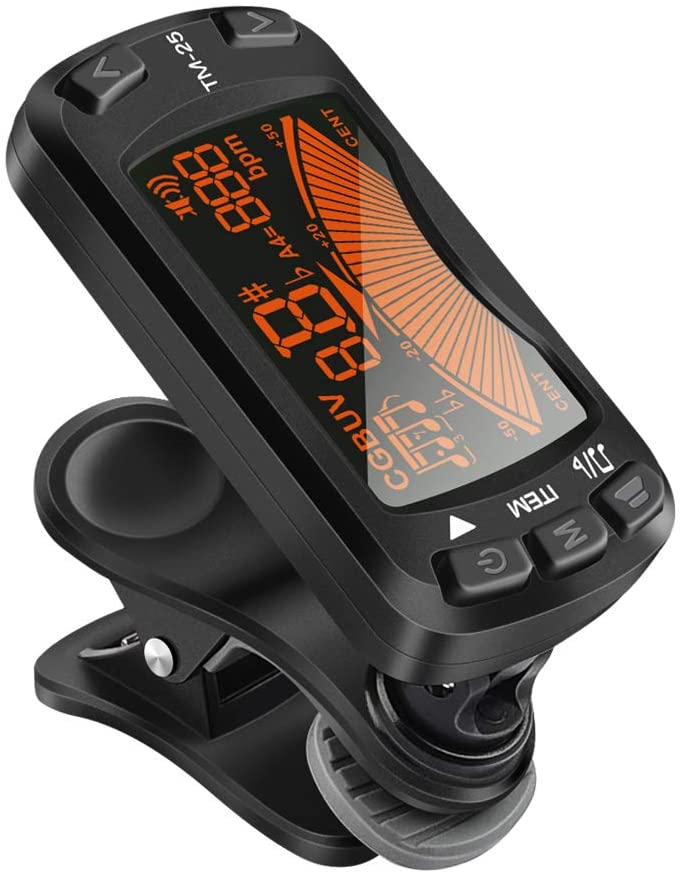
The LEKATO Guitar Clip-On Metronome is a compact and lightweight device that combines a tuner, metronome, and tone generator into one.
It features an easy-to-read LCD display and a 360-degree rotatable clip for convenience and easy use.
With a wide range of applications, this LEKATO metronome is suitable for all instruments including guitars, basses, violins, and ukuleles.
It also features an intelligent auto power-off function that conserves battery life, which is ideal if you’re someone who often forgets to turn off their devices.
In addition, each shutdown can automatically save the current parameters so you never have to worry about losing your settings.
Whether you’re a beginner or a professional, the LEKATO Guitar Clip-On Metronome is a great tool to have on hand to help you keep in time and in tune.
Besides that, the device has a tempo range of 30-250 beats per minute so that you can find the perfect tempo for your practice session or performance.
The power button doubles as a play/stop button for the metronome so you can easily control it with one hand.
Whether you’re just starting out or you’ve been playing for years, this seems like a decent product to have on hand in my opinion.
Pros:
- Compact and lightweight design
- Features a tuner, metronome, and tone generator
- 360-degree rotatable clip for
Cons:
- Hard to clip on some instruments
Soundbrenner Wearable Vibrating Metronome
(link to Amazon.com)
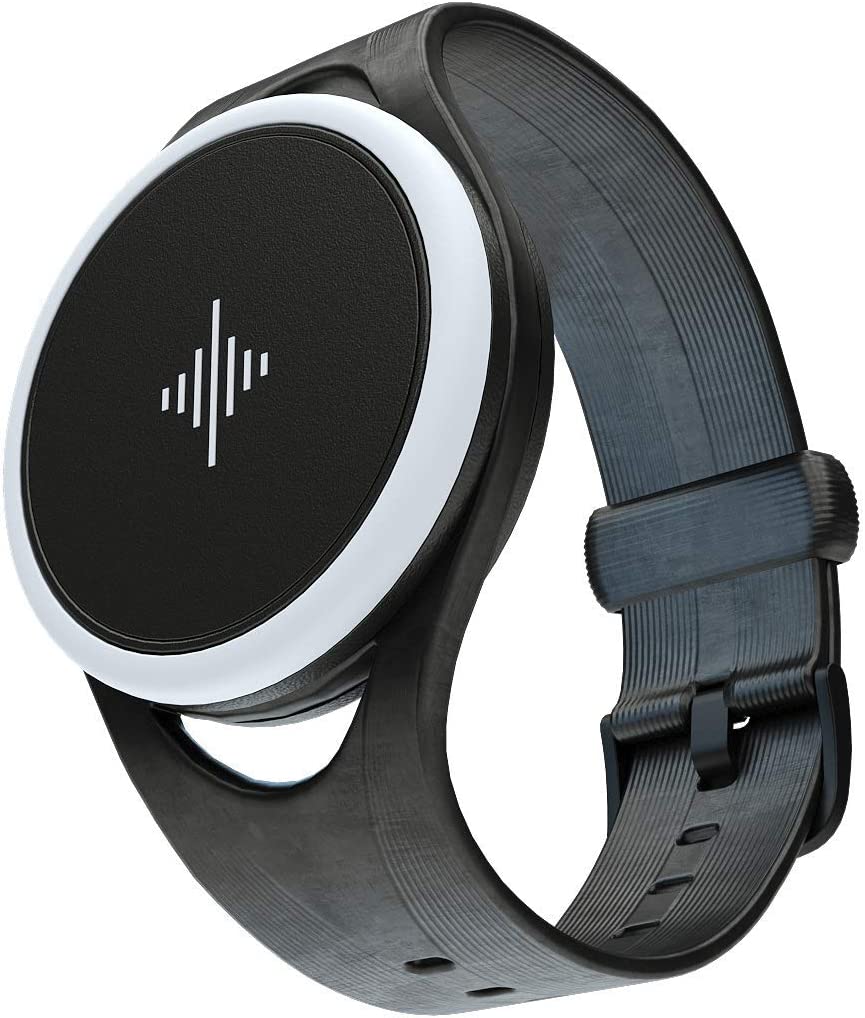
The Soundbrenner Wearable Vibrating Metronome is a metronome that uses vibrations instead of clicks to help you keep time.
In other words, as you can see from the image above, this is something you’d have to wear somehow to experience the vibrations, for example in your arms or around your waist.
The thinking behind this is that vibrations are 7x more powerful than the average vibration of a smartphone, so you’ll be less likely to miss a beat or be unable to keep up with the tempo.
You can also connect up to 5+ devices via NFC/Bluetooth and sync them up with your bandmates or friends, which is a neat feature.
This is especially useful if you’re in a live setting and need to keep everyone on the same page, which usually would only be the drummer that’s doing all the work.
You can also create and save rhythms in the setlist library, which is a nice touch that allows you to keep everything organized through the mobile app.
The Soundbrenner metronome is also DAW (Digital Audio Workstations) compatible, which means that it can receive input from all major DAWs via USB MIDI.
This includes popular software such as FL Studio, Ableton, Logic, and Pro Tools.
This is a great tool for any musician, whether you’re a beginner still trying to get the hang of things or a seasoned pro who wants an easy way to keep everyone on tempo.
The fact that it’s wearable is also a huge plus, as it frees up your hands and allows you to focus 100% on your playing.
Pros:
- Wearable and vibrating design
- Syncs with other devices
- Compatible with most DAWs
Cons:
- Can be fragile if not handled carefully
Donner DPM-1 Mechanical Metronome
(link to Amazon.com)
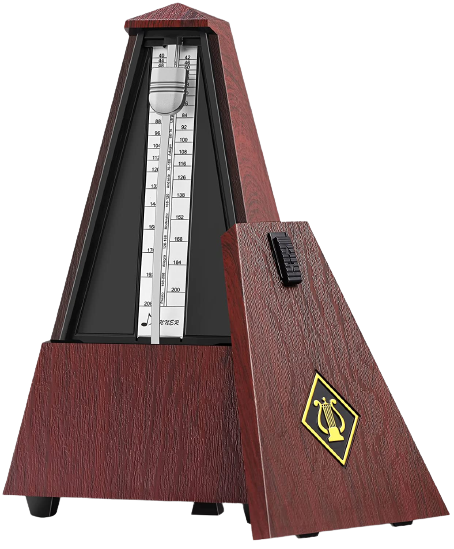
The Donner DPM-1 Mechanical Metronome is a precision instrument that is designed to help musicians keep time while playing their instruments.
It features a classic pyramid tower design, with a pendulum in the center, and is made from high-quality materials for durability.
This metronome is easy to use and has a wide range of applications, making it a great choice for any musician who’s looking to improve their skills.
It features a spring mechanism that gives it the power to produce regular, metrical beats and has a tempo range of 40 to 208 bpm with a tolerance of 1%.
What this means is that it is an extremely accurate metronome that will help you play with greater precision and improve your overall musicianship.
This metronome is also equipped with a wood block chip sound and a 5 position on/off bell, making it a great tool for learning and practicing music.
Also, it is very economical since, like most mechanical metronomes, it is powered by a wind-up spring mechanism and does not require batteries.
As for colors available, it comes in black, brown, red, and natural.
Pros:
- Extremely accurate with a 1% tolerance
- Easy to use and affordable
- Durable design
Cons:
- It may be too simple in features for some users
Korg MA-1 Visual Beat Counting Metronome
(link to Amazon.com)
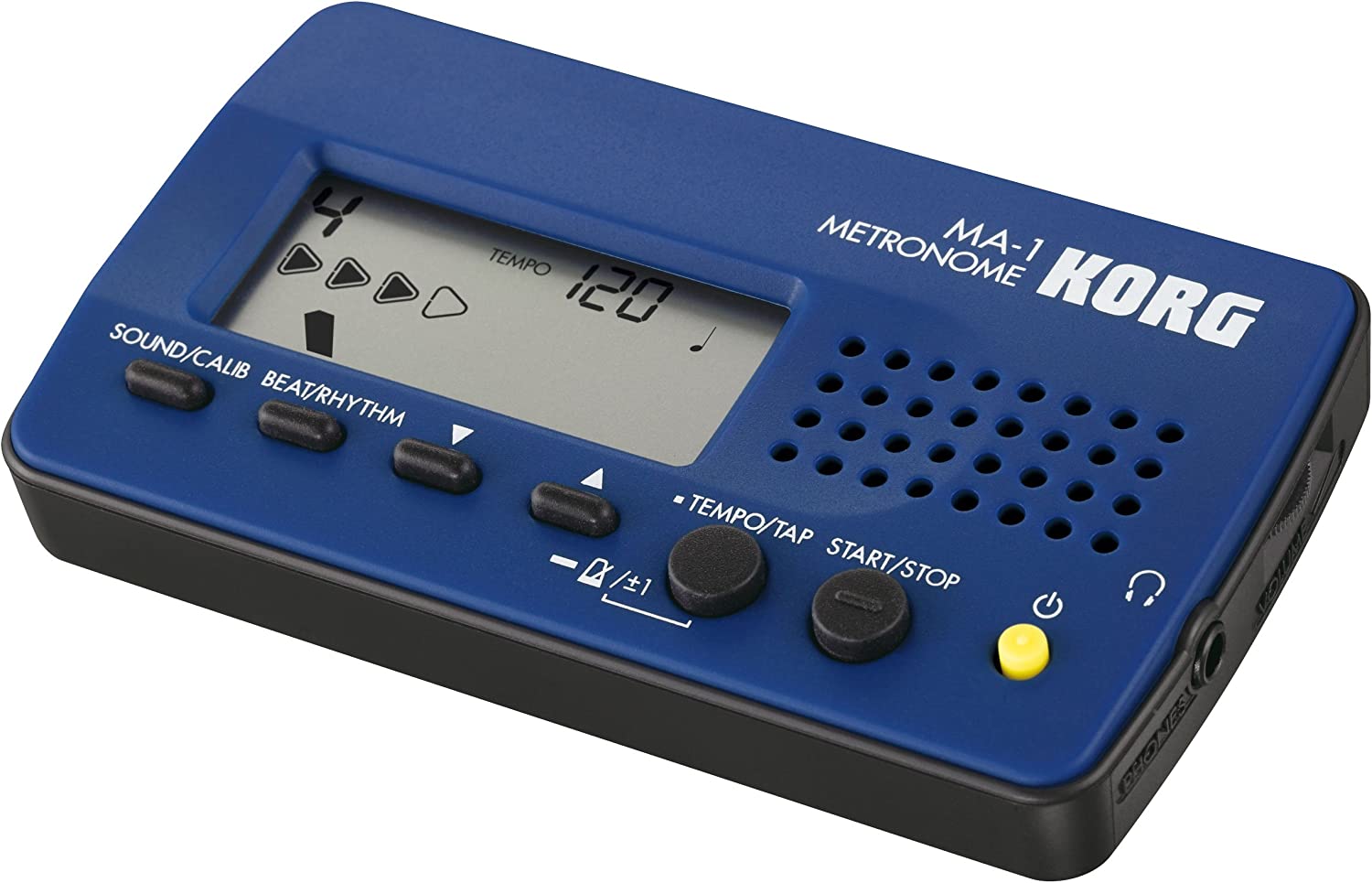
The Korg MA-1 is a visual beat counting metronome that makes practicing rhythm and phrasing easier.
It has a tempo range of 30 to 252 BPM, three tempo settings, and an earphone jack with adjustable volume.
Additionally, the metronome has a memory backup function and an auto power-off function which are both useful for not losing your selected settings and saving battery life.
This metronome also comes with a folding leg for easy viewing and placing it on a flat surface.
It also takes two included AAA batteries and has a battery life of approximately 70 hours when using zinc-carbon batteries.
The beat display offers from 1 to 9 beats, plus 8 rhythm types to practice any style of music which makes it a versatile tool.
Aditionally, it is available in two color schemes: blue and black, or black and red.
One of its useful features is also the tap tempo function that lets you quickly set the desired tempo of your playing session.
Besides that, its display will show you the number of beats in a measure and the current beat of the measure, so you can have a clear idea of when measures will change.
Pros:
- A bright, clear, and simple-to-read display
- Has a tap tempo function
- Memory backup is available
Cons:
- Must use 2 AAA batteries
- Available in 2 colors
Seiko SQ50-V Quartz Metronome
(link to Amazon.com)
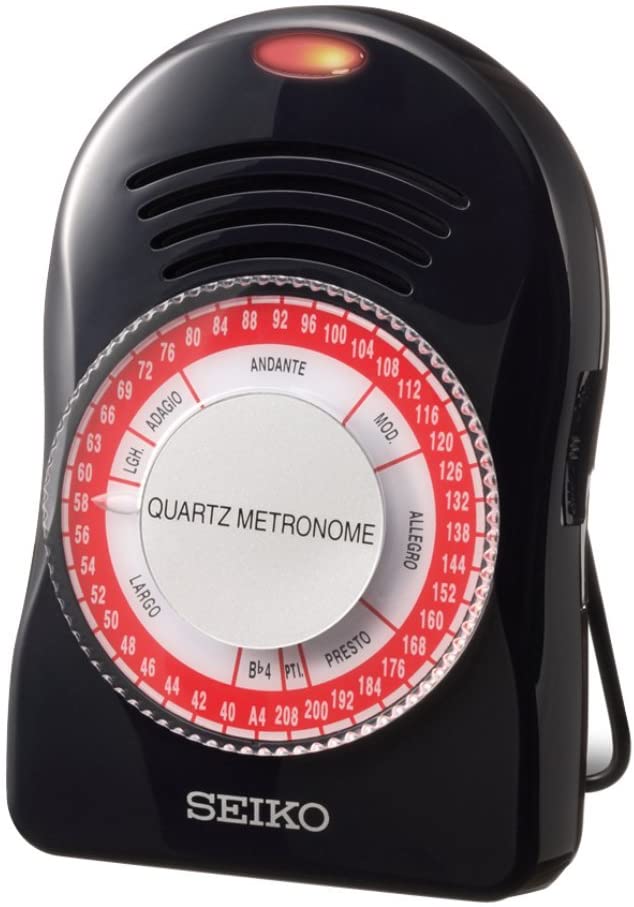
The Seiko SQ50-V Quartz Metronome is an easy-to-use, reliable metronome that is perfect for both practicing at home and performing onstage.
With a choice of two different sounds for tempo and beat, and a bright red LED visual tempo indicator, this metronome is great for use without an audible click or during a performance.
In other words, this LED can and will help you keep on tempo even if you can’t hear the metronome.
The 39-position rotary dial allows for easy tempo selection from 40-208bpm, and the built-in fold-out stand provides stable placement on any flat surface.
As an essential tool for any musician, this Seiko metronome is sure to help keep you in time and sound your best for quite a decent price.
This device also offers a reference tuning tone for A (440) and Bb (446.1), which can come in handy whether you’re practicing or performing.
To top it all off, something that I really liked about this metronome, in particular, is that it labels the tempo types on the front of the unit for easy identification.
Pros:
- Easy to use and reliable
- Red LED visual tempo indicator
- 39-position rotary dial for easy tempo selection from 40-208bpm
Cons:
- Not too many extra features beyond the basics
Korg KDM-3 Metronome
(link to Amazon.com)

The Korg KDM-3 Metronome is a stylish, modern metronome that offers a variety of features and functions.
It has eight metronome sounds, including a mechanical metronome sound, and 19 beat patterns to support songs of any genre.
At the same time, it also has an easy-to-use one-touch operation and an easily-readable display which are helpful for any musician.
This metronome is packed with convenient functions that you would expect from a digital unit, making it a great choice for any performer.
These include being able to visually see the tempo, and the metronome information, as well as having an idea of which beat you are on.
As for volume, the KDM-3 is well-known for its powerful volume and its clearly audible tone, which can be easily adjusted using the simple controls on the device.
In addition, on its side, it labels the many types of tempos that can be set on the metronome, which are prestissimo, presto, allegro, moderato, andante, adagio, larghetto, and largo.
This is a great way to mix things up and actually know the terms and theory behind what you’re playing.
Pros:
- Stylish design
- 19 beat patterns support songs of any genre
- One-touch operation
- Packed with convenient functions
Cons:
- Can be expensive for some people.
What to consider before buying a guitar metronome?
Since buying a metronome can be a tricky task, especially if you’re not sure what to look for, here are a few things to consider before making your purchase:
1. Type of metronome
– Mechanical
This type of metronome uses a pendulum to keep time.

Generally, they’re more accurate than electronic metronomes but can be a bit more expensive.
One of the main advantages of mechanical metronomes is that they don’t require batteries, so you’ll never have to worry about them running out of power.
Additionally, many people find the ticking sound of a mechanical metronome to be more soothing than the beeping sound of an electronic one.
We recommend:
– Electronic digital
This type of metronome uses a digital display and emits a beeping sound to keep time.

They’re usually more affordable than mechanical metronomes and are often smaller and more portable.
One of the main advantages of electronic metronomes is that they offer a variety of features and settings that can be customized to your specific needs.
Some of these features include different rhythms, time signatures, and tempo settings.
We recommend:
– Computer or app-based
This type of metronome is either a program or app that you can download onto your computer or smartphone.
One of the main advantages of using a computer or app-based metronome is that they’re usually very affordable, if not free.

Additionally, many of these metronomes offer a variety of features and settings that can be customized to your specific needs.
Since they’re on your computer or phone, they’re also very portable and can be taken with you wherever you go.
Also, the nature of software allows for regular updates which can add new features and improve the overall performance of the product.
We recommend:
2. Brand
There are many guitar metronome brands out there.
You want to make sure you buy a reputable brand that makes quality products.
Sometimes, it’s worth spending a little extra on a quality product that will last longer and from a company that cares about its customers.
A good brand will also have good customer service in case you have any issues with your product and is going to go above and beyond to help you fix any problem.
3. Quality
When looking for a guitar metronome, you want to make sure it is of good quality.
A quality metronome will keep time accurately and have a clear sound, plus it should also be durable so that it can withstand being dropped or knocked around.
The materials used to make the metronome should also be of good quality so that it looks nice and works well.
Aside from that, it is also important that the metronome is able to do its job without being too complicated to use.
A quality product will have user-friendly features, an easy-to-read display, and it will also be very self-explanatory to use.
4. Price
You don’t want to spend too much money on a guitar metronome, but you also don’t want to buy something that is cheaply made and won’t last.
A good rule of thumb is to find a balance between quality and price.
There are many affordable options out there that are still of good quality, so don’t feel like you have to spend a lot of money to get a good metronome.
Think about whether you want features like a built-in tuner, different tempo settings, or a metronome that attaches to your guitar.
Unfortunately, though, the more features a metronome has, the more expensive it will be, but if those features are important to you then it is worth the extra cost.
5. Extra features
– Multiple time signatures
One extra feature that can be helpful is the ability to change the time signature.
This can be useful if you are playing in a band that uses different time signatures or if you are practicing for a solo performance where you might need to change up the tempo frequently.
Some metronomes even have pre-programmed rhythms so that you can practice your timing with different styles of music.
This can be a great way to improve your sense of rhythm and timing.
– Tap tempo
Another great feature is the ability to set the tempo by simply tapping on the device.
This can be very helpful if you are trying to match the tempo of a song that you are playing along to.
It can also be helpful if you are trying to find a comfortable tempo to play without having to fiddle with buttons or dials.
How it works is that you simply tap on the device in time with the music and it will automatically set the tempo for you.
– Visual cues
Some metronomes also provide visual cues in addition to the audible click.
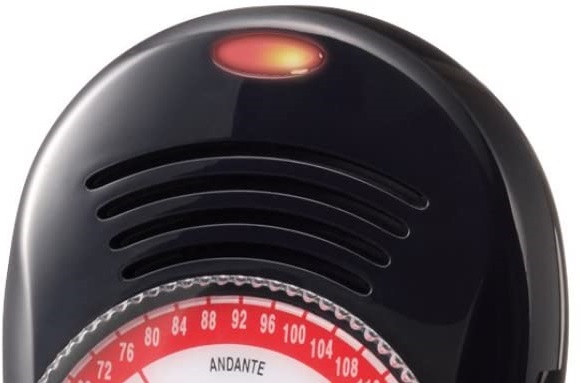
If you are having trouble hearing the metronome or if you want to be able to see the tempo as well as hear it, this can be a great feature to look for.
A few of them even have a backlit display so that you can see the tempo in low-light situations.
– Display
The display on a metronome can also be an important consideration; this is not the same as visual cues.
Some metronomes have very simple displays that only show the tempo, while others have more complex displays that show the time signature, tempo, and even the subdivision of the beat.
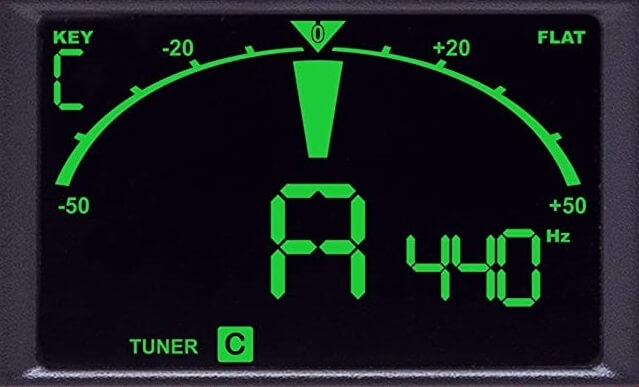
If you are planning on using your metronome for more than just keeping time, a more complex display can be very helpful.
This is also especially useful if you are a visual learner and find it useful to see the tempo as well as hear it.
– Memory/storage capacity
Some metronomes also have the ability to store tempos and rhythms.
If you find yourself using the same tempo or rhythm frequently, then this can be a very helpful feature to look for.
Some metronomes even have the ability to connect to a computer so that you can save and recall tempos and rhythms with the click of a button.
For those who play live shows, then looking for a metronome that has this feature is a no-brainer, since you will be able to instantly recall the perfect tempo for each song without having to fiddle with buttons or dials onstage.
6. Size and portability
If you are planning to use your metronome during performances, then you need to make sure that it is small and portable enough to be carried around with you.
On the other hand, if you are only going to be using it at home, then size and portability may not be as big of a concern.
You should consider the places where you will be using your metronome before making a purchase.
This is due to the fact that a larger metronome can be difficult to transport and may not even fit in a guitar case.
Additionally, a metronome that is too small might be difficult to see and use, especially if you have large hands.
7. Ease of use
Another important consideration is how easy the metronome is to use.
You should make sure that the controls are intuitive and easy to access because the last thing you want is to be fumbling with the controls while trying to keep a steady beat.
Additionally, you might want to consider purchasing a metronome that has a built-in display so that you can easily see the tempo and the current time signature.
If you are a beginner, you might want to look for a metronome that has a tutorial mode so that you can learn how to use it effectively.
Usually, fewer buttons or dials are better as they are easier to use and very unlikely to get accidentally changed in the middle of a session.
Additionally, many metronomes now come with an app that you can download onto your phone or tablet, which can be very helpful if you want to use your metronome on the go.
8. Others
Some other things to look out for include the battery life of the metronome and the quality of the beep sound.
You don’t want your metronome to run out of battery in the middle of a performance, so it is important to make sure that it has long battery life.
Additionally, the beep sound should be clear and precise so that it doesn’t get lost in the mix.
You might want to test out different metronomes in person to see which one has the sound quality that you are looking for.
This is usually one of the main concerns with people that buy cheap metronomes.
Having a beep sound that’s annoying to the ear can make people not want to use the metronome, which kind of defeats the purpose.
How accurate are metronomes?
The answer to this question depends on the specific metronome you are using.
Generally speaking, metronomes are quite accurate and can be used to keep time for a variety of purposes.
Any discrepancies in accuracy are usually quite small, unnoticeable to the average person, and will not have a significant impact on most people’s ability to use the metronome for its intended purpose.
Some high-end metronomes can be extremely accurate, with some models boasting an accuracy of up to +/- 0.1%.
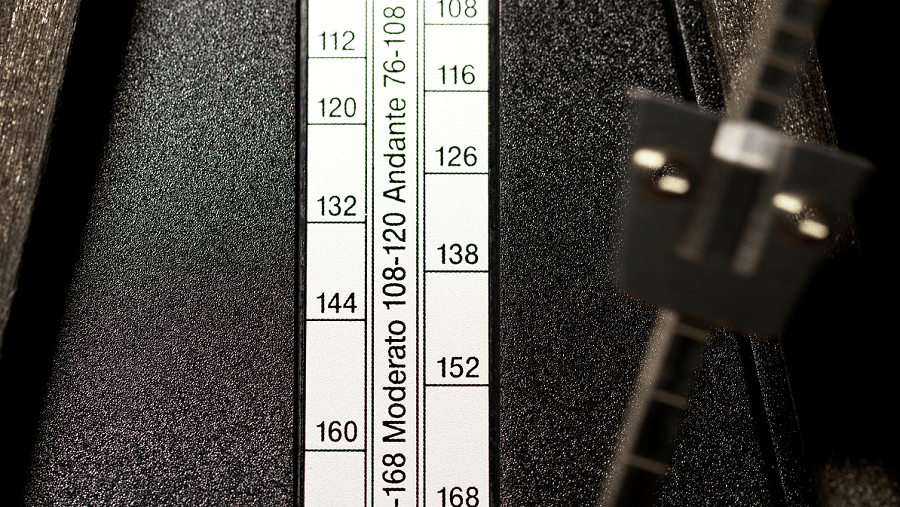
If you are looking for a super accurate metronome, you may want to consider investing in a more high-end model, but for most people, a standard metronome will suffice.
However, like any tool, they are not perfect, and there is always some margin for error.
If you need absolute precision, you may also want to consider a click track, which they use in recording studios to keep time with absolute precision.
It consists of a series of clicks or tones that are played back at a specific rate and helps to ensure that all instruments in a recording are playing in time with each other.
Is BPM the same thing as tempo?
No, BPM (beats per minute) and tempo are not the same things.
Tempo is the speed of a piece of music, while BPM is a measure of the number of beats in a minute.
Thus, a piece of music with a slow tempo can have a high BPM if there are many beats per minute and vice versa.
The two concepts are related, but they are not the same.
An easy way of seeing this can be to think of BPM as the ‘pulse’ or ‘heartbeat’ of a piece of music, while the tempo is the speed at which that heartbeat goes.
There are many different types of tempo, some of them include:
- Larghissimo: very, very slow (24 BPM and below)
- Grave: slow and solemn (25-45 BPM)
- Lento: slowly (45-60 BPM)
- Largo: broadly (40-60 BPM)
- Adagio: slow and stately (66-76 BPM)
- Andante: at a walking pace (76-108 BPM)
- Moderato: moderately (108-120 BPM)
- Allegro: fast, quick, and bright (120-156BPM)
- Presto: extremely fast (168-200BPM)
- Prestissimo: Lighting speed (>200BPM)
You might ask, why are these terms in Italian?
Well, back in the day, tempo indications were given in Italian because most of the early most important composers of the 17th century were Italian.
Nowadays, these terms are used universally, regardless of language.
Should you always practice guitar with a metronome?
In general, it’s a good idea to practice with a metronome at least some of the time.
While metronomes are a great tool to help improve your sense of timing and rhythm, there are also situations where it might be better to practice without one.
For example, if you’re working on a new piece of music and are having trouble nailing down the timing, it can be helpful to slow things down and practice without a metronome.
This would mean taking it as slow as you possibly can while still being able to play all the notes correctly and focus only on the technical aspects of the performance.
Practicing with a metronome will help ensure that you can play accurately at any tempo, but practicing without one will challenge you to maintain yourself at a consistent tempo.
There is no one-size-fits-all answer to this question, both approaches have their merits, so ultimately it’s up to you to decide what works best for you.
Or you can simply mix them all together!
If you’re struggling with timing or rhythm, then practicing with a metronome can be a great way to improve those skills.
However, if you’re already confident in your abilities and are just looking to fine-tune your performance, then practicing without a metronome may be more beneficial.
No matter what route you choose, the important thing is that you’re consistently practicing and challenging yourself to improve.
What is a good BPM to practice guitar?
There is no definitive answer to this question as the ideal BPM (beats per minute) will vary depending on the individual and the specific guitar technique being practiced.
However, a general rule of thumb is that a slower BPM is better for learning new techniques, while a faster BPM is better for mastering existing techniques.
Additionally, it is important to find a BPM that is comfortable for you and allows you to play with proper form and technique.
I’d start with around 60-70 BPM and then gradually increase the speed as you get more comfortable with the technique.
Once you feel like you’ve plateaued, you can do two things:
Stay at that BPM and play it until you can’t get it wrong anymore.
Or, increase the BPM slightly and continue practicing.
Remember, there is no “right” answer, so it ultimately comes down to what works best for you and your own personal playing style.
Should all musicians in a band have a metronome when playing together?
While there are differing opinions on whether or not all musicians in a band should have a metronome when playing together, the general consensus is that it can be beneficial.
Having everyone on the same page with regards to tempo can help keep the band sounding tight and cohesive.
Additionally, it can be helpful for nailing down specific parts of songs that might be giving people trouble.
The problem is though, that getting all metronomes to match up perfectly can be difficult, and if someone is playing with a click track that is slightly off, it can end up throwing the whole band off.
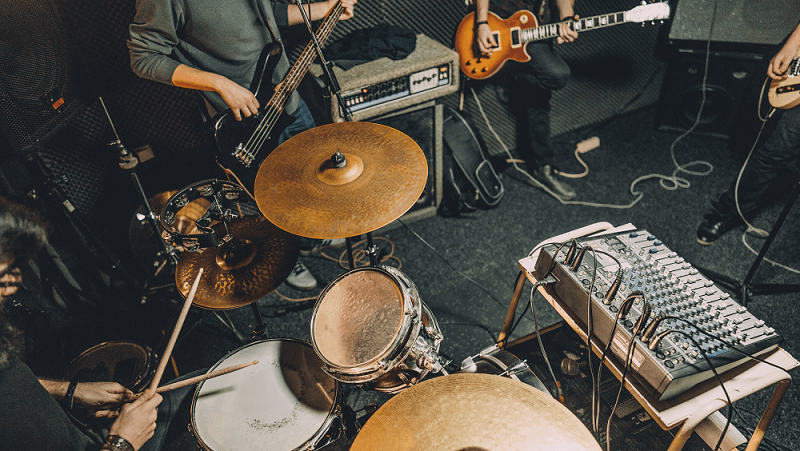
There’re certainly some digital devices that we can use to help keep everything in sync through technology.
At the end of the day, it really comes down to each individual band member being aware of their own playing and being able to stay on time.
It wouldn’t be as fun if everyone was playing to a metronome, but at the same time, it can be frustrating when people are constantly speeding up or slowing down.
A good way to find a middle ground might be to have some members of the band use metronomes while others just play by feel.
Or to do so in practice sessions and then decide as a band whether or not it’s something that you want to incorporate into your live performances.
Generally, it’s only the drummer that uses a metronome when playing live.
The other band members will then just adjust to the tempo set by the drummer.

Born and raised in Florida! I’ve been playing guitars for the past 5 years. Love to learn, and I’m always striving to achieve greater heights in music. Currently have a Fender Stratocaster as my main guitar.

